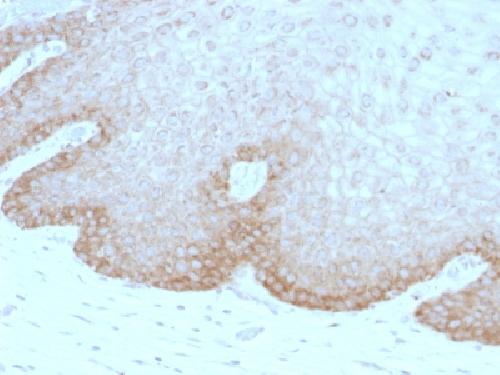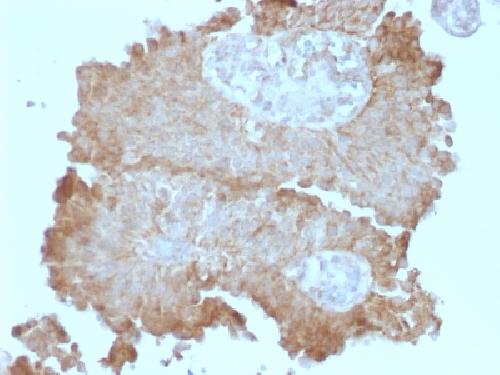Anti-Protocadherin FAT2 (FAT Atypical Cadherin 2) Antibody
Mouse Monoclonal Antibody
- 产品详情
- 实验流程
- 背景知识
Application
| IHC-P, IF, FC |
|---|---|
| Primary Accession | Q9NYQ8 |
| Other Accession | 591255 |
| Reactivity | Human |
| Host | Mouse |
| Clonality | Monoclonal |
| Isotype | Mouse / IgG1, kappa |
| Clone Names | 8C5 |
| Calculated MW | 479317 Da |
| Gene ID | 2196 |
|---|---|
| Other Names | FAT tumor suppressor homolog 2 (HFAT2); cadherin family member 8 (CDHF8); cadherin-related family member 9 (CDHR9); multiple EGF-like domains protein 1; multiple epidermal growth factor-like domains 1 (MEGF1); multiple epidermal growth factor-like domains protein 1; protocadherin FAT2. |
| Application Note | Flow Cytometry (0.5-1ug/million cells); Immunofluorescence (1-2ug/ml); ,Immunohistology (Formalin-fixed) (0.5-1ug/ml for 30 min at RT),(Staining of formalin-fixed tissues requires boiling tissue sections in 10mM Citrate Buffer, pH 6.0, for 10-20 min followed by cooling at RT for 20 minutes),Optimal dilution for a specific application should be determined. |
| Format | 200ug/ml of Ab purified from Bioreactor Concentrate by Protein A/G. Prepared in 10mM PBS with 0.05% BSA & 0.05% azide. Also available WITHOUT BSA & azide at 1.0mg/ml. |
| Storage | Store at 2 to 8°C.Antibody is stable for 24 months. |
| Precautions | Anti-Protocadherin FAT2 (FAT Atypical Cadherin 2) Antibody is for research use only and not for use in diagnostic or therapeutic procedures. |
| Name | FAT2 |
|---|---|
| Synonyms | CDHF8, KIAA0811, MEGF1 |
| Function | Involved in the regulation of cell migration (PubMed:18534823). May be involved in mediating the organization of the parallel fibers of granule cells during cerebellar development (By similarity). |
| Cellular Location | Cell membrane; Single-pass type I membrane protein. Cell junction. Golgi apparatus, trans-Golgi network {ECO:0000250|UniProtKB:O88277}. Note=Localized at adhesion zippers (early state of adherens junctions) of keratinocytes |
| Tissue Location | Expressed in epidermal keratinocytes, infant brain, cerebellum, and also in a variety of tumors, such as pancreatic cancer, diffuse type gastric cancer, ovarian cancer, esophageal cancer, skin squamous cell carcinoma, head and neck cancer. Not expressed in melanoma cell line A375 cells, normal epidermal melanocytes or normal dermal fibroblasts. Expressed in epidermal keratinocytes and squamous cell carcinoma (at protein level). |
For Research Use Only. Not For Use In Diagnostic Procedures.
Provided below are standard protocols that you may find useful for product applications.
BACKGROUND
Recognizes a protein of 480kDa, which is identified as FAT2. The cadherins represent a family of Ca2+-dependent adhesion molecules that function to mediate cell-to-cell binding that is critical for the maintenance of structure and morphogenesis. Cadherins each contain a large extracellular domain at the N-terminus, which is characterized by a series of five homologous repeats, the most distal of which is thought to be responsible for binding specificity. The relatively short C-terminal intracellular domain interacts with a variety of cytoplasmic proteins, including β-catenin, to regulate cadherin function. The cadherin superfamily includes cadherins, protocadherins, desmogleins and desmocollins. FAT2 (FAT tumor suppressor homolog 2) is a single-pass type I membrane protein that belongs to the protocadherin subfamily of cadherins. FAT2 contains one Laminin G-like domain, two EGF-like domains and 32 cadherin domains and is believed to function as a cell adhesion molecule, controlling cell proliferation and playing an important role in cerebellum development.
终于等到您。ABCEPTA(百远生物)抗体产品。
点击下方“我要评价 ”按钮提交您的反馈信息,您的反馈和评价是我们最宝贵的财富之一,
我们将在1-3个工作日内处理您的反馈信息。
如有疑问,联系:0512-88856768 tech-china@abcepta.com.























 癌症的基本特征包括细胞增殖、血管生成、迁移、凋亡逃避机制和细胞永生等。找到癌症发生过程中这些通路的关键标记物和对应的抗体用于检测至关重要。
癌症的基本特征包括细胞增殖、血管生成、迁移、凋亡逃避机制和细胞永生等。找到癌症发生过程中这些通路的关键标记物和对应的抗体用于检测至关重要。 为您推荐一个泛素化位点预测神器——泛素化分析工具,可以为您的蛋白的泛素化位点作出预测和评分。
为您推荐一个泛素化位点预测神器——泛素化分析工具,可以为您的蛋白的泛素化位点作出预测和评分。 细胞自噬受体图形绘图工具为你的蛋白的细胞受体结合位点作出预测和评分,识别结合到自噬通路中的蛋白是非常重要的,便于让我们理解自噬在正常生理、病理过程中的作用,如发育、细胞分化、神经退化性疾病、压力条件下、感染和癌症。
细胞自噬受体图形绘图工具为你的蛋白的细胞受体结合位点作出预测和评分,识别结合到自噬通路中的蛋白是非常重要的,便于让我们理解自噬在正常生理、病理过程中的作用,如发育、细胞分化、神经退化性疾病、压力条件下、感染和癌症。







